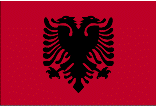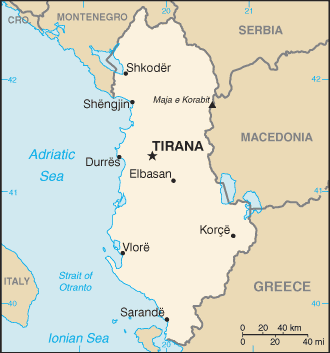|
Albania
|

|
Capital: Tirana (Tirane)
Population: 2,880,917
Brief History of Albania:
Albania is one of those countries or areas in the world that has been ruled by a number of empires and other countries due to its location. Situated next to Greece and along the Adriatic Sea, it has been a strategic land mass during many international conflicts.
The land was first settled by a tribe of people called the Illyrians in about 2000 BC. The Romans were one of the first empires to conquer the land and Albania was part of first the Roman Empire and then later the Byzantine Empire or Eastern Roman Empire. In the 1300s, the Ottoman Empire took control. Much of the country's population converted to Islam during this time. In the mid-1400s the Albanians managed to gain independence from the Ottomans for a short time under the leadership of national hero Gjergj Kastrioti Skenderbeu. However, the Ottoman's soon took back control.
The Albanians fought for their independence several times over the course of history. They achieved it briefly a few times, but finally became a nationally recognized country in the early 1900s.
During World War II, Albania was occupied by both Germany and Italy. After the war the communist party took over. The country would remain under communist rule for the next 40 plus years until it would finally have democratic elections in 1992. The first democratic elected president of Albania was Sali Berisha. Today, however, the country is still in some turmoil with both the democratic and communist parties vying for power. The country would like to join the European Union, or the EU, but as of 2010 still has a number of conditions it needs to meet.
The Geography of Albania
Total Size: 28,748 square km
Size Comparison: slightly smaller than Maryland
Geographical Coordinates: 41 00 N, 20 00 E
World Region or Continent: Europe
General Terrain: mostly mountains and hills; small plains along coast
Geographical Low Point: Adriatic Sea 0 m
Geographical High Point: Maja e Korabit (Golem Korab) 2,764 m
Climate: mild temperate; cool, cloudy, wet winters; hot, clear, dry summers; interior is cooler and wetter
Major cities: TIRANA (capital) 433,000 (2009), Durres, Vlore
The People of Albania
Type of Government: emerging democracy
Languages Spoken: Albanian (official - derived from Tosk dialect), Greek, Vlach, Romani, Slavic dialects
Independence: 28 November 1912 (from Ottoman Empire)
National Holiday: Independence Day, 28 November (1912)
Nationality: Albanian(s)
Religions: Muslim 70%, Albanian Orthodox 20%, Roman Catholic 10%
National Symbol: double-headed eagle
National Anthem or Song: Hymni i Flamurit (Hymn to the Flag)
Economy of Albania
Major Industries: food processing, textiles and clothing; lumber, oil, cement, chemicals, mining, basic metals, hydropower
Agricultural Products: wheat, corn, potatoes, vegetables, fruits, sugar beets, grapes; meat, dairy products
Natural Resources: petroleum, natural gas, coal, bauxite, chromite, copper, iron ore, nickel, salt, timber, hydropower
Major Exports: textiles and footwear; asphalt, metals and metallic ores, crude oil; vegetables, fruits, tobacco
Major Imports: machinery and equipment, foodstuffs, textiles, chemicals
Currency: lek (ALL)
National GDP: $25,320,000,000
** Source for population (2012 est.) and GDP (2011 est.) is CIA World Factbook.
Back to Geography Home Page
